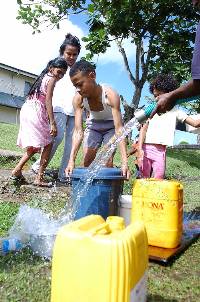 RAINWATER can be a good supplement to the country's water needs if tapped into and used effectively. It is useful and free but a highly under utilised freshwater resource, especially in cities and towns. But a large proportion of people living in rural areas and outer islands have their own rainwater tanks for water supply.
RAINWATER can be a good supplement to the country's water needs if tapped into and used effectively. It is useful and free but a highly under utilised freshwater resource, especially in cities and towns. But a large proportion of people living in rural areas and outer islands have their own rainwater tanks for water supply.
The Secretariat for the Pacific Islands Applied Geoscience Commission said rainwater was generally considered as a safe source of water supply. SOPAC's water services coordinator, Tasleem Hasan said contamination of rainwater only occured with the collection and storage methods.
"In such cases, the drinking water safety planning concept or sanitary inspections are very useful in ensuring the safe quality of water from rainwater systems," he said.
Mr Hasan said rainwater collected off the roofs could get contaminated if there were bird droppings on the roof.
He said dust and debris which accumulated on the roof and gutters washes into the tank and over time forms a layer of sludge at the bottom.
"As a result, it becomes a breeding ground for bacteria as the inside of the tank gets dirty, thus contaminating the rainwater collected in it," he said.
"Bacteria can also enter the tank and contaminate water if there are visible cracks in the tank and the tap is leaking."
Mr Hasan said failure by people to cover or secure the manhole or opening to the tanks could also contaminate rainwater collected inside.
"And last but not least, corroded roofing material and guttering and no first flush device can also result in water contamination."
"It's very simple to manage and take care of some of the risks mentioned and it would go a long way in keeping your rainwater safe for consumption.
"We should all do our part. Utilise more rainwater, collect, store and use safely because after all it's free," said Mr Hasan.
Safe hygiene practices
CLEAN water collected can be contaminated prior to use at critical points because of unsafe hygiene practices. It is therefore important for people to realise that contamination of water could pose potential risks to public health.
As such,
DON'T:
* Use dirty containers to collect water from tank or draw water from wells
* Transport water from the supply to the house in dirty or open containers
* Store water in open or dirty containers
* Use a dirty container like cup to scoop water from the storage vessel
* Use dirty hands to scoop water out. Hands among other things get dirty if you visit the toilet and do not wash them properly with soap and water
DO:
* Use a clean container to collect water from the source of supply
* Use a clean container to take water out of the storage vessel
* Store water in a secure location where children and animals cannot reach it
* Ensure the container you store water in is cleaned regularly.
* Keep drinking water in a clean separate container from water used for other domestic purposes
If household water storage is being practiced by households and communities, then these should be noted.
Source: SOPAC
Caption: Residents of Valelevu police quarters, front, Saimoni Dausiga, Shahista Dutt and Evia Rasoma fill water from a water truck.
Picture: IVAMERE ROKOVESA, Fiji Times
